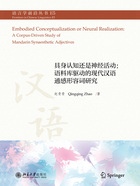
1.1.1 Transfer patterns
Existing studies on linguistic synaesthesia are mostly based on Indo-European languages and focus on the transfer directions of lexical items between sensory modalities. These studies have all demonstrated that linguistic synaesthesia follows directionality tendencies (Ullmann 1957; Williams 1976; among others). Such tendencies are described in two different transfer models in the literature.
The first model originated from research on linguistic synaesthesia in poetic languages by Ullmann (1945,1957,1966 [1963]). Based on around 2,000 synaesthetic examples collected from English, French, and Hungarian poems from the nineteenth century, Ullmann (1957)found that over 80% of the synaesthetic expressions conformed to the directional pattern described by the model in Figure 1.

Figure 1 A linear model for linguistic synaesthesia (adapted from Ullmann 1957)
Shen (1997)confirmed this linear model for Hebrew poetry. In addition, Shen (1997), Shen and Cohen (1998), Shen and Eisenman (2008), and Shen and Gadir (2009)demonstrated the validity of the model with various experimental studies on linguistic synaesthesia in non-poetic Hebrew and English, which involved tasks such as interpretation generation, recall, naturalness judgments, and so forth. For example, they have showed that synaesthetic expressions that conform to the directional tendency (e.g.,stinking paleness)are easier to recall and are judged as more natural than expressions that violate the tendency (e.g., pale stink). Shen and Gil (2008)conducted both corpus-based and experimental studies on linguistic synaesthesia in Indonesian, showing that the directional tendency described in Figure 1 also holds. However, all these studies on linguistic synaesthesia in non-Indo-European languages by Shen’s team are based on a small data sample, in terms of both the corpus data for generalizing directional tendencies and the testing stimuli utilized in the cognitive experiments. For instance, Shen (1997)utilized 130 synaesthetic instances of poetic Hebrew, and Shen and Gil (2008)employed 125 synaesthetic examples of non-poetic Indonesian to verify the transfer patterns of linguistic synaesthesia in each language. With respect to the experimental study by Shen and Gadir (2009), there are only two testing stimuli for each combination between any two of five senses.
Strik Lievers (2015)employed a larger data sample extracted automatically from the Wacky corpora (Baroni et al.2009)through a computational approach to test the linear transfer model for linguistic synaesthesia in non-poetic English and Italian. The study verified the model in Figure 1 for both English and Italian synaesthesia. Furthermore, Strik Lievers (2015:69)claimed that the directional tendencies of linguistic synaesthesia should be interpreted as “frequency” rather than as absolute constraints. The claim entails that linguistic synaesthesia shows directional preferences, where synaesthetic mappings in one direction occur more frequently than those in the reverse direction, rather than stating that the mappings in the reverse direction cannot be found in real languages. However, Winter (2019a)pointed out a problem in Strik Lievers’ (2015)corpus-based study with respect to methodology. That is, Strik Lievers (2015)did not take into consideration the distinction between types and tokens of synaesthetic transfers, both of which should be considered to determine the mapping directionality for linguistic synaesthesia (Winter 2019a).
Williams (1976)proposed a second linguistic synaesthesia transfer model, as shown in Figure 2. By referring to the citation dates in the Oxford English Dictionary (OED)and Middle English Dictionary (MED), Williams generalized the model through focusing on the adjectives used for more than one sensory domain in the history of English. Williams assumed that English sensory adjectives would follow this model when they changed their meanings among sensory modalities, and that if synaesthetic transfers violated the pattern, the resultant sensory meanings would become obsolete in the language. For instance, the study illustrated that the tactile meaning of the adjective eager was not retained in Standard English, although the adjective had a tactile meaning as the result of a transfer from taste to touch in the history of English (see Williams 1976:476). Furthermore, Williams suggested that the hierarchy described in Figure 2 should be applicable to any language, given the universality of the biological nature of human sensory modalities.

Figure 2 A transfer hierarchy for linguistic synaesthesia (Williams 1976:463)
Lehrer’s (1978)synchronic study on English sensory adjectives corroborated this model, but challenged the exclusive reliance on citations in dictionaries by Williams (1976), in consideration of the lack of written materials for earlier periods of English. She added that some unpredicted transfers by the model in Figure 2 could still be used in English, such as the dimension item fat(belonging to vision)employed for taste (Lehrer 1978:120).
The two transfer models assign an identical directional rank to touch, taste, and smell, as seen in Figures 1 and 2. The main difference between the two models is the relationship between vision and hearing: while hearing precedes vision in Figure 1, both directions between hearing and vision are possible in Figure 2. The discrepancy is not, strictly speaking, contradictory, as Williams’(1976)model in Figure 2 classified vision into two different sub-domains: dimension and color (Zhao et al.2018b). Since both are models of directional tendencies that do not claim to be strict rules, the same set of data could be consistent in both models. In addition, Winter (2019a)has observed that Williams’(1976)hierarchy of English synaesthesia is compatible with but stronger than Ullmann’s (1957)linear model (cf. Figure 1), as the former makes more falsifiable predictions and constraints for linguistic synaesthesia. In sum, studies on linguistic synaesthesia in Indo-European languages such as English and Italian, and non-Indo-European languages including Hebrew and Indonesian, have confirmed that different languages can share tendencies of directionality in synaesthetic transfers.